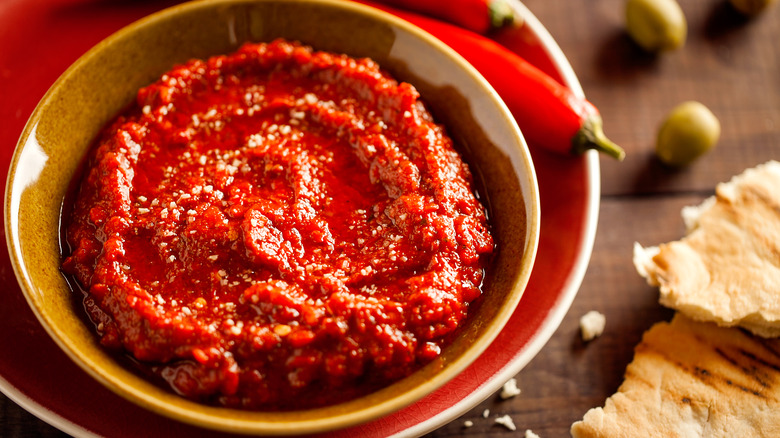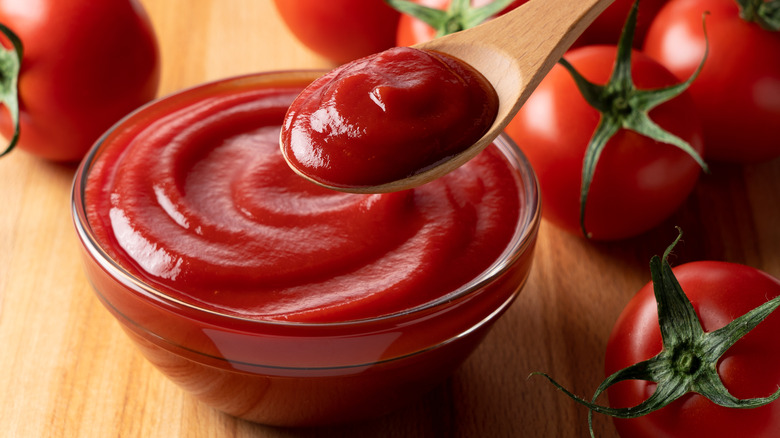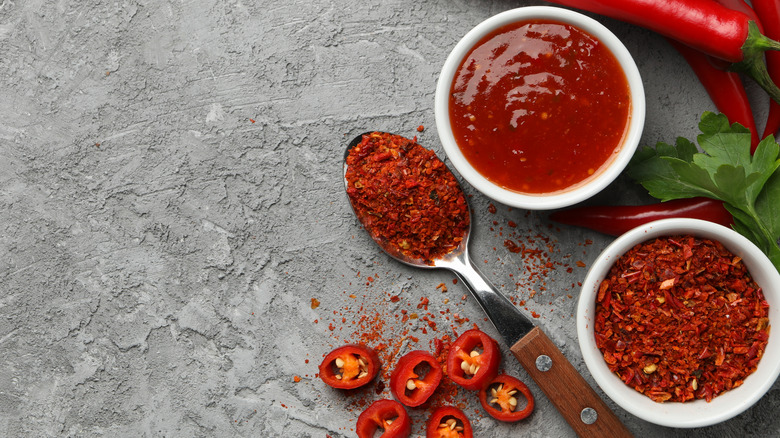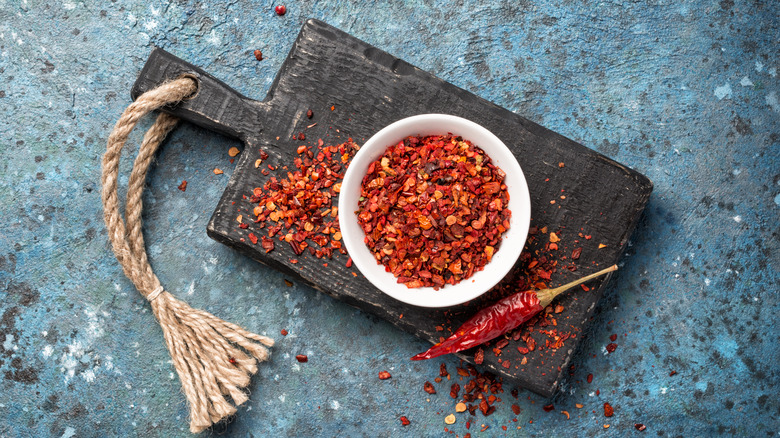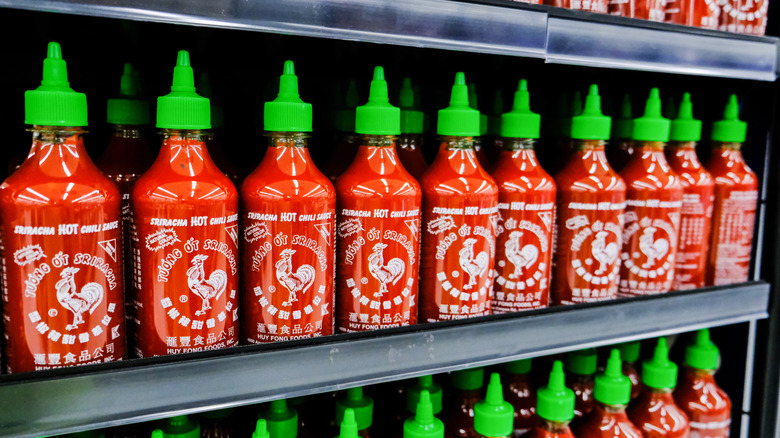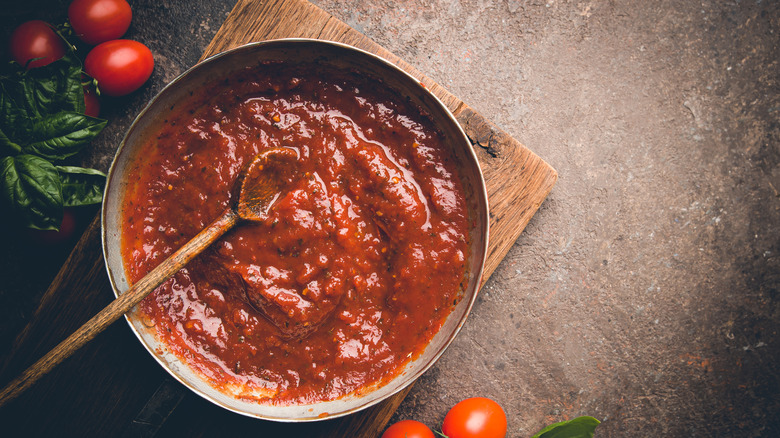6 Best Substitutes For Chili Paste
When you want to find new ways to heat things up in the kitchen, get familiar with chili paste. There are general types of chili paste you can buy from the store, but you can also grab some chili pastes from around the world, including gochujang, a standard ingredient in Korean cooking, and harissa, a crowd-pleasing North African condiment. According to The Kitchn, chili paste is one of the few spicy condiments that Sunny Anderson always has in her kitchen. The primary ingredient in chili paste is dried chili pepper that has been ground up into a thick puree (via Recipe Marker). From adding it to a soup for extra heat and flavor to using it as a zesty spread on sandwiches, chili paste is a staple ingredient you'll appreciate having handy.
Even if you don't have any chili paste lying around, you don't have to hurry back to the grocery store. There are many substitutes for chili paste you can use to achieve similar results, but alternative spicy paste you decide to use in your dish might rely on what you have lying around your kitchen or pantry. Depending on what flavors and textures are in your dish, different ingredients might produce better results, so choose wisely.
1. Ketchup with ground cayenne pepper
Ketchup makes an ideal substitute for chili paste, as these two condiments share a similar texture. Unlike chili paste, which has a pepper base, ketchup is primarily a tomato concentrate from red ripe tomatoes and can include ingredients such as distilled vinegar, high-fructose corn syrup, corn syrup, salt, spice, onion powder, and natural flavorings (via Washington Post). Take note — ketchup and chili paste have very different flavor profiles. While ketchup has a sweet undertone to it, chili paste has a whole lot more heat. By adding some cayenne pepper to your ketchup mixture, you give this substitute the sharp kick it needs to maintain the zest required in your dish. Cayenne pepper works perfectly, as it's a type of hot chili pepper that chefs typically use to ratchet up the heat level in savory dishes (per Medical News Today).
Add two tablespoons of cayenne pepper to every one cup of ketchup you include in your recipe. If your dish only calls for a small amount of chili paste, blending one to two teaspoons of cayenne pepper in with some ketchup does nicely (per Leaf). If a recipe calls for smaller amounts of chili paste, this ingredient can be replaced with a 1:1 ratio of cayenne pepper to ketchup.
2. Ketchup with crushed red pepper
If you don't have any ground cayenne pepper in your kitchen, don't worry. Mixing ketchup with crushed red pepper flakes also makes a fine substitute for chili paste, and will add the same fiery flavor to whatever meal you're cooking up (via Grill Your Life). As a double bonus, red pepper flakes consist primarily of cayenne pepper, among a handful of other varieties, according to Bon Appétit. This flavor profile gives this substitution the kick you need. Keep in mind, this substitute also has a distinctly different flavor from chili paste, due to its tomatoey base. Before using this substitute, consider the recipe you need to make and whether or not the tomato-like flavor could negatively impact the dish.
If you decide to opt for this backup ingredient, add a few shakes of red pepper flakes to your ketchup blend to taste. Then, stir it all together. Just like that, your chili paste alternate is ready to add to your recipe, featuring a 1:1 ratio of flakes to ketchup (per Food Gear). If you want your meal to pack a punch, you can even add a few extra shakes of red pepper flakes to your ketchup mixture.
3. Crushed red pepper flakes
Crushed red pepper flakes are an easy substitute for chili paste that adds an extra level of heat to your dish and you probably even have this ingredient waiting for you on your spice rack already. These spicy flakes simply consist of dried and crushed cayenne peppers. Each jar of the spice has a high percentage of seeds, which add a very hot flavor to this ingredient. While crushed red pepper flakes make a suitable stand-in for chili paste, they lack a similar consistency, which might be important for the dish you are concocting. If you need a pastier substitute, add some sugar and soy sauce in with your flakes.
Combine a tablespoon of red pepper flakes, a smidgeon of soy sauce, several sprinkles of sugar, and stir it all together (via Pepper Scale). This gives you a sweet and spicy chili paste that tastes similar to gochujang. Whatever the amount of chili paste your recipe calls for, replace it with the same amount of this mixture. Alternatively, add red pepper flakes directly to your dish to taste. If you like your food hot and spicy, you might even sprinkle some flakes on top of your meal when it's ready to serve.
4. Sriracha hot sauce
If you're in a bind, Sriracha makes an excellent food substitute for chili paste. Before opting for this alternative, keep in mind the slight differences in consistency and taste between these two spicy condiments. Sriracha tends to be much thinner and runnier compared to a traditional chili paste (via Recipe Marker). If you want to thicken up your sauce, add some sweet paprika to the mix to do the trick. Many varieties of hot sauce have a tangy, vinegar taste to them, making these condiments less ideal. For this reason, Sriracha sauce beats out many other hot sauces, as it has more of a garlic flavor and a thick, paste-like consistency.
For every teaspoon of Sriracha that replaces a standard chili paste, add one teaspoon of sweet paprika. This alternate ingredient can be substituted with a 1:1 ratio of Sriracha to sweet paprika.
5. Spicy tomato paste
Spicy tomato paste is not a go-to substitute, but if the consistency of the chili paste remains a priority in your recipe, then this ingredient could be a good backup for you. Thanks to tomato paste lacking the spiciness that chili paste possesses, you need to add some pepper flakes or chili powder to your mixture. Bear in mind that this stand-in ingredient adds a distinct tomato flavor, similar to ketchup, and acidic tang to your recipe. If you don't think this flavor pairs well with your dish, it might be worth it to scrounge for an alternate ingredient (per Pepper Scale).
Replace the same amount of chili paste your recipe calls for with tomato paste. Combine your tomato paste with a dash of pepper flakes or chili powder, or both, if you want to amp up the heat level (via Chili Pepper Madness). When your texture is on the line, you might have to resort to spicy tomato paste in a pinch.
6. Make your own
If you don't have any of the substitutes listed above, don't panic. Making your own chili paste couldn't be simpler, and might even make the best substitute of them all. Even the most amateur home chefs and beginner cooks can knock this recipe out of the park. So put on your apron and get ready for the best substitute of them all. This delicious homemade chili paste tastes most similar to sambal oelek, a chili paste that originates from Indonesia (per Serious Eats). According to Pepper Scale, all you need for this recipe are four simple ingredients — 1 pound of chilies, 1 teaspoon of salt, a bit of vinegar, and equal part water. In terms of your chilis, Fresno and red Serrano peppers make for the perfect addition if you are looking for a paste with medium spice. If you want to take it up a notch, opt for Thai chilis for an extra hot experience. Remove all of the seeds from the chilis, and roughly chop them up.
After your ingredients get prepped, use a food processor to grind up your chilis into a thick paste with some water. Then, cook your chilis on a saucepan for approximately three to five minutes. Last but not least, add in your vinegar and salt, and mix it all together (via Pepper Scale). Voilà! Your chili paste is ready to be served. For an optimal tasting experience, either serve right away or refrigerate overnight.
